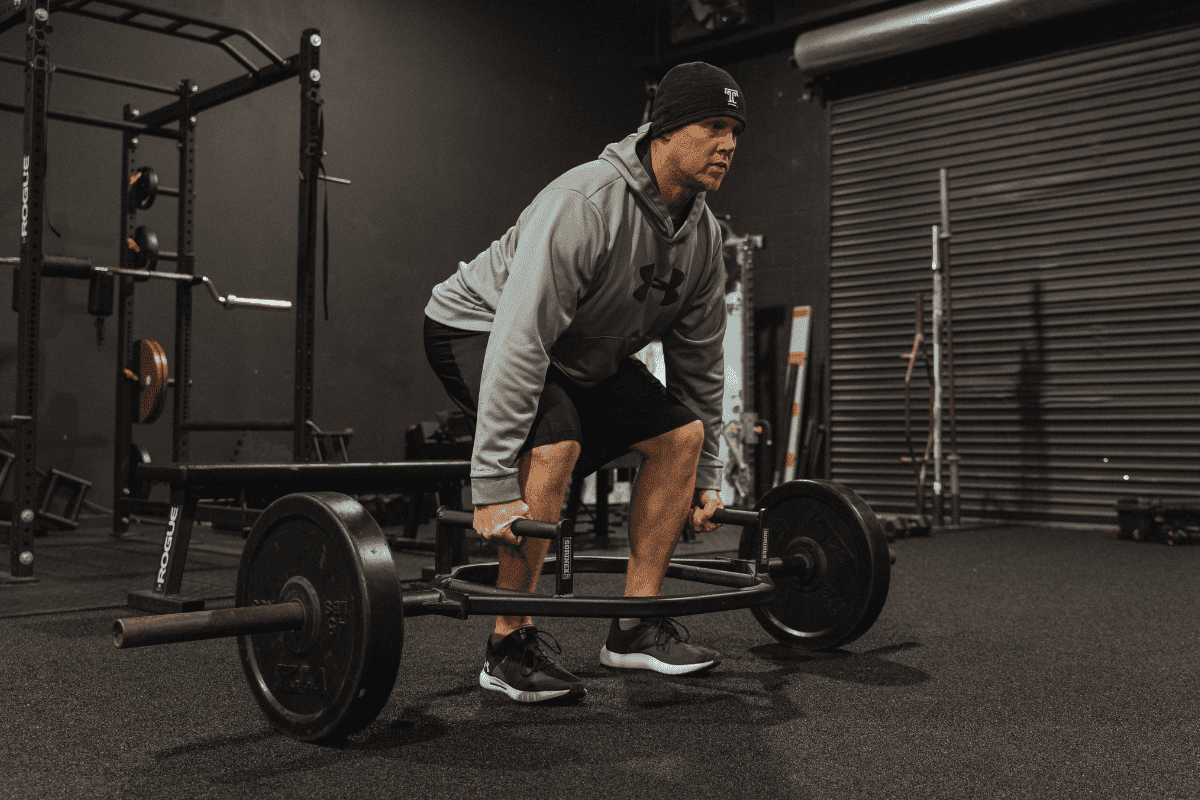How Much Does a Hex Bar Weigh? (15 Bars Compared)
A Hex Bar (or Trap Bar as it’s often called) is a specialty bar that is many times the first bar added to a home gym after a standard barbell.
But, unlike standard Olympic barbells that all weigh 45 pounds, hex bars carry vary in weight from one company, and style, to another. Hex bars can weigh as little as 40 pounds and as much as 75 pounds.
For this article, I hunted down every hex bar from a reputable gym equipment company that I could find and put them all into the table located below so you can quickly compare hex bars from over a dozen different brands.
In addition to their weight, I also took note of each bar’s dimensions because those also vary from one hex bar to the next.
This article contains affiliate links. If you make a purchase through these links I may, at no extra cost to you, earn a commission.
Hex Bars Weight Chart
| How Much Does a Hex Bar Weigh | ||||
| Brand | Hex Bar | Weight | Dimensions (L x W x H) | |
| Titan | Rackable Hex Trap Bar V2 | 60 lbs | 85.5″ x 28.5″ x 7.5″ | |
| Titan | Olympic Hex Weight Bar | 44 lbs | 56″ x 22.75″ x 6″ | |
| Titan | EZ Load Hex Bar | 54 lbs | 66.33″ x 30.9″ x 10″ | |
| Rogue | TB-2 Trap Bar | 60 lbs | 88.5″ x 28.5″ x 9″ | |
| Rogue | TB-1 Trap Bar 2.0 | 60 lbs | 89″ x 28.5″ x 3″ | |
| Sorinex | Diamond Bar (Double Handle) | 70 lbs | 86.625″ x 27.625″ x 6″ | |
| Bells of Steel | Olympic Open Trap Bar | 47 lbs | 59″ x 22.24″ x 4.88″ | |
| Fringe Sport | Hex “Trap” Bar | 45 lbs | 56″ x 23.375″ x 5.25″ | |
| American Barbell | Hex Bar | 40 lbs | 85″ x ???* x ???* | |
| American Barbell | Dual Height Fat Grip Hex Bar | 55 lbs | 85″ x ???* x ???* | |
| Perform Better | Mega Trap Bar | 75 lbs | 88″ x 28.25 x ???* | |
| Perform Better | Olympic Combo Hex Bar | 45 lbs | 56″ x 25″ x ???* | |
| Power Systems | Diamond Pro Hex Barbell | 60 lbs | ???* | |
| Power Systems | Hex Bar | 59 lbs | 56.25″ x 23″ x ???* | |
| Cap Barbell | Olympic Trap Bar | 46 lbs | 55.12″ x 24.61″ x 2.17″ | |
*American Barbell (as well as a few other brands) does not give width and height dimensions on their website for their Hex Bar.
My Recommendations

In case you’re curious, my recommendation would be one of the heavy-duty trap bars like the Rackable Hex Trap Bar V2 from Titan or the Rogue TB-2 Trap Bar. (I also love the Sorinex Diamond Bar pictured above but it is a bit expensive for a home gym)
Yes, they cost a bit more, but these bars are both massive, heavy-duty trap bars.
I don’t have to worry about running out of room loading plates onto the sleeve and both of these bars are able to be loaded onto a power rack like a standard straight barbell.
This makes shrugs way less of a pain to set up and use a trap bar for.
If you want something that is going to take up less of a footprint or if you want to save a few bucks, I’d go a different route.
But, if you want an absolute tank of a trap bar – either of these bars from Titan or Rogue will be a great addition to your home gym (or commercial gym for that matter).
Army Combat Fitness Test Standard Weight
If you are looking to get a hex bar that meets the Army Combat Fitness Test Standard (ACFT), you need a hex bar that weighs 60 pounds.
Why Does Hex Bar Weight Matter?
The reason it’s important to know how much your hex bar weighs is that it can drastically affect the total amount of weight you’re lifting.
Imagine for a second that your strength program calls for you to Bench Press 225 for 5 reps. However, the bar you happen to use that day weighs 30 pounds more than the bar you normally use. Would that make a difference? Absolutely!
It’s no different with a hex bar. Hex Bars weigh anywhere from roughly 45 pounds to 75 pounds. If you have a 400-pound deadlift that would be a 7.5% difference. That’s a big difference if you’re trying to be specific with your programming loads.
Hex Bar FAQ

Is It Hex Bar or Trap Bar?
Either works.
The Hex Bar is called a hex bar because the bar creates the shape of a hexagon. It’s this hexagon that you stand in the middle of for deadlifts.
However, the term Trap Bar is used just as commonly and the two are completely interchangeable.
In fact, I realized while writing this article that I personally refer to the bar as a Hex Bar, but I also use the term Trap Bar Deadlift to describe the exercise. This doesn’t really make sense, but it shows you just how interchangeable the terms are.
It’s often thought that the name Trap Bar came to be because the bar is often used for shrugs that work the traps, hence Trap Bar.
Whichever you decide to call it, hex bar or trap bar, rest assured that almost all lifters will know exactly what you’re referring to either way.
Why are Hex Bars So Popular?
Hex bars are popular because they allow the lifter to get in a more advantageous position at the start of a deadlift.
Because the middle of the bar is open, you’re able to shift your weight back more to your midfoot and heel compared to a conventional deadlift. This shift, along with elevated handles, usually allows the lifter to start with a more upright torso at the start.
This combination can take a lot of the stress off the low back which is why many people like to use a hex bar either in place of or even in addition to conventional deadlifts.
The more ‘lifter-friendly’ starting position also makes it slightly easier for beginners to pick up as well.
They don’t have to concern themselves with the bar crossing the knees which can sometimes cause technique errors (by wanting to swing the bar out in front of the knees) in new lifters.
Not only is the starting position easier for beginners, but for lifters with limited mobility (through their hamstrings, low back and/or Achilles), they may find the trap bar deadlift starting position easier to attain as well.
What Are The Benefits of a Hex Bar?

The main benefit in my opinion is that it allows lifters that may not be comfortable deadlifting with a straight barbell the ability to perform pulls from the ground.
I’ve had athletes who exclusively did trap bar deadlifts and trap bar pulls because doing these exercises with a straight bar irritated their backs. This benefit alone made hex bars worth their weight in gold in my opinion.
By being able to start in a more mechanical advantaged position, a hex bar not only takes some stress off the posterior chain, but it also allows the lifter to lift more weight.
Raised handles, depending on the height, can also play a major factor in being able to lift more weight with a trap bar.
Depending on the exact bar, a lifter can usually lift around 10-15% more weight than with a straight barbell.
Being able to lift more weight can lead to improved strength and increased mass. Both are huge benefits for pretty much anyone lifting weights.
Is a Hex Bar Deadlift Easier?
Easier is a relative term.
Is the starting position easier to get into? Yes. Does a trap bar deadlift put less stress on the low back than a conventional deadlift? Yes. Are you able to lift more weight? Yes.
Having said all that, put enough weight on a hex bar and you’ll find a hex bar deadlift every bit as challenging as a regular deadlift.
Are All Hex Bars The Same?
No.
For starters, hex bars come in a huge variety of sizes and weights as the table above clearly illustrates.
In addition to a conventional hex bar, there is now what is called an open hex bar. These open hex bars are open on one side, making them 3/4 of a hexagon.
With no bar on the one side it opens up the possibility for more exercises than can be performed with a conventional hex bar.
Lunges and Split Squats are probably the two most popular movements that can be done with an open hex bar, but farmer’s walks (especially if done as some sort of competition) are a bit safer with an open hex bar as well.
Can You Squat With a Hex Bar?
With enough determination, you can do any exercise with any bar. However, would I recommend trying to squat with a hex bar? No.
Hex Bar Exercises (Other Than Deadlift)
So what other exercises can be done with a hex bar other than deadlift? Because as awesome as trap bar deadlifts are, paying over $100 for a bulky bar to sit in your garage gym for one exercise seems a little excessive.
Shrugs are a favorite exercise of mine with a hex bar. You can use a couple of 45-pound plates or a pull box to elevate the bar off the ground more for shrugs.
Farmer’s walks are a staple hex bar exercise. Most people are able to load more weight onto a hex bar than they have 100 plus dumbbells lying around which makes the hex bar a great farmer’s walk option.
Bent over rows and Romanian deadlifts (RDL) can also be done with a hex bar.
Finally, a slightly more unconventional lift I like to do with hex bars is the overhead press. Curling the bar up into the starting position is a bit of a challenge, but once you get it into position it’s a great bar for overhead pressing.
Final Thoughts
Knowing the weight of your equipment is something that is important to be able to track your progress across all your lifts and knowing the weight of your hex bar is no different.
Hopefully, this article helped you find the weight of your hex bar or perhaps helped you with purchasing the hex bar weight that you were specifically looking for.
If you found this article helpful, I also have articles breaking down the weights of all kinds of different barbells as well as a complete database for over 100 different squat rack dimensions.
Stay Strong!

